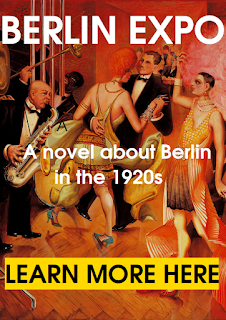Going to the movies
in our days is a completely different experience from back in
the 20s. Uniformed ushers, 80-instrument orchestras, lavishly
decorated theaters. Manhattan boasted venues like Capitol and Roxy,
but also Berlin had its luxury movie theaters.
That was partly a
consequence of the American influence on the German film industry.
UFA, the biggest film producer in Germany, hired the
american-european agent and impresario Sam Rachmann to revamp its
show theater, UFA-Palast am Zoo.
Its opening took
place on September 24th 1925. « Redecoration of the interior in
purple and gold and installation of multicolored spotlights provided
a Broadway ambience. The renovated cinema opened with three hours of
uninterrupted entertainment. »
Ever since its opening in 1919, the Ufa-Palast am Zoo had been UFA’s uncontested flagship. After remodeling bv Carl Stahl-Urach (the architect behind Haus Vaterland) in 1925, it contained 2,165 seats. On the outside it resembled a massive Romanesque citadel whose stonework and square tower were evocative of "Germanic heritage." The interior shone all red and gold with soft, heavy purple on the floors and walls. Pleated gold curtains, illuminated by dozens of spotlights, provided an uninterrupted play of fantastic color.
Ventilation was supplied by "an electric zeppelin that swept through the house during intermissions and sprayed eau de Cologne about with an atomizer."
 |
| By Willy Pragher, CC BY 3.0, https://commons.wikimedia.org/w/index.php?curid=37104981 |
The broad avenue in the photo above is the Hardenbergstrasse. In the background, the Kaiser Wilhelm Memorial Church (Gedächtniskirche). The arrow to the left shows the Ufa-Palast am Zoo with entrance from Hardenbergstrasse.
Rudi Feld (1896-1994), an artist and art-director who would later pursue his career in Hollywood, was in charge of the opulent « stage shows » preceding the films as well as of the effectful exterior displays on the theater's facade, different for each movie.
« The bizarre theater interiors and stage shows were meant to put spectators in a festive mood, to steer their attention tactfully toward the feature, and to make them receptive to its message. And in their outdoor ads, with full-color pictures of the stars, gigantic letters, and neon figures, film over-whelmed architecture. The sensations of the screen leaped out onto the street, scattering their tidings about in the hectic life of the city. With his ingenious manipulation of light and movement, Rudi Feld, Ufa's advertising chief, transformed theater facades into huge screens and showplaces for spectacular mechanical effects. »
The facades of the theater changed from day to day, but all that glitter also helped to disguise the fact that most of the people in the audiences were living under difficult conditions. The contrast between these oppressive economic problems and the glowing image presented to the world, was in some way characteristic of the Weimar years.
The Ufa-Palast am Zoo was the venue for the majority of the important films of the decade, other theaters being the Gloria-Palast, the Capitol am Zoo, the Marmorhaus, among other elite cinemas. Productions which are now regarded as classics, like Der letzte Mann, Metropolis, Faust, Frau in Mond, M, were shown at Ufa-Palast for the very first time.
The feature film at the opening in 1925 was
a comedy with Sydney Chaplin (Charlie’s elder half-brother) :
Charley’s Aunt. And the entertainment included a
ballet company directed by Alexander Oumansky and a 75-man orchestra
directed by Ernö Rappée playing the Tannhäuser overture, as well
as jazz tunes.
The names Rappée and Oumansky don't mean much today, but in those years they
were not just anybody. Only the Best and the Most were good enough for
UFA, or for flamboyant Sam Rachmann at any rate.
Alexander Oumansky
(1895-1983) was a dancer and choreographer of Ukrainian origin. He
belonged to Diaghilev’s Russian ballet. He emigrated later to the
US and worked with the dancers of another famous movie theater, New
York’s Capitol, where even Ernö Rapée was musical director.
Rapée (1891-1945)
was a famous conductor and composer who had already made a career in
the U.S. and became later head conductor of the Radio City Symphony
Orchestra in New York. Born in Estonia, he had attended the musical
academy of Budapest. While in Berlin, he was invited to conduct the
Berlin Philharmonic Orchestra in a concert. One of his best known
compositions is Charmaine.
Information from the book: "The Ufa Story A
History of Germany's Greatest Film Company, 1918-1945" by Klaus
Kreimeier, 1999.



No comments:
Post a Comment